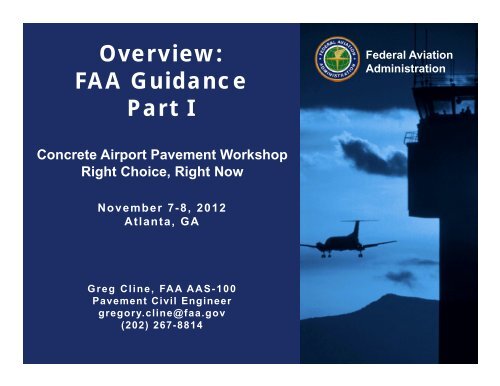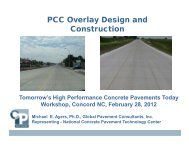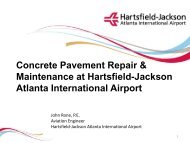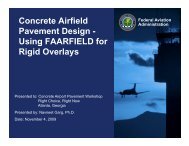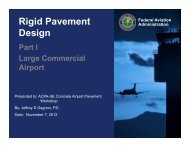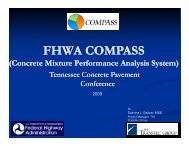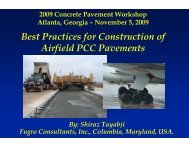FAA Guidance Part I - American Concrete Pavement Association
FAA Guidance Part I - American Concrete Pavement Association
FAA Guidance Part I - American Concrete Pavement Association
Create successful ePaper yourself
Turn your PDF publications into a flip-book with our unique Google optimized e-Paper software.
Overview:<br />
<strong>FAA</strong> <strong>Guidance</strong><br />
<strong>Part</strong> I<br />
Federal Aviation<br />
Administration<br />
<strong>Concrete</strong> Airport <strong>Pavement</strong> Workshop<br />
Right Choice, Right Now<br />
November 7-8, 2012<br />
Atlanta, GA<br />
Greg Cline, <strong>FAA</strong> AAS-100<br />
<strong>Pavement</strong> Civil Engineer<br />
gregory.cline@faa.gov<br />
(202) 267-8814<br />
Federal Aviation<br />
Administration<br />
0
Presentation Objectives<br />
<strong>FAA</strong> Airports Safety & Standards Engineering Division<br />
<strong>Guidance</strong> Available at <strong>FAA</strong> Airports<br />
Summarize / Provide information on <strong>Pavement</strong> related<br />
Advisory Circulars (AC) and Engineering Briefs (EB)<br />
Priorities and Direction for FY13 and Beyond<br />
Availability of Research and Development Products<br />
Federal Aviation<br />
Administration<br />
1
Airport Engineering Division AAS-100<br />
• Division Manager John Dermody<br />
• Assistant Manager (primarily for Airports GIS)<br />
• Administrative Assistant<br />
• National Resource Expert on Air Space<br />
• 7 Civil Engineers (2 pavements)<br />
• 3 Electrical/Electronics Engineers<br />
• ACRP Research Engineer (Mechanical)<br />
• Airport Safety Data Program (Program Manager)<br />
• Airports GIS (Computer Scientist)<br />
• Technical Support Contractor (ISI)<br />
Federal Aviation<br />
Administration<br />
2
<strong>FAA</strong> <strong>Guidance</strong><br />
• <strong>FAA</strong> guidance is part of the authorizing<br />
legislation for airport development using<br />
Federal funds.<br />
• <strong>FAA</strong> airport design, construction, and<br />
maintenance guidance are contained in<br />
Advisory Circulars, the 150’s series.<br />
• Interim <strong>FAA</strong> airports engineering guidance is<br />
provided in Engineering Briefs.<br />
• <strong>FAA</strong> airport guidance is available from <strong>FAA</strong><br />
web sites: http://www.faa.gov/arp/<br />
Federal Aviation<br />
Administration<br />
3
Establishing or Changing <strong>Guidance</strong><br />
• HQ Office Initiates and Prepares Draft.<br />
• Review by HQ Airports Offices.<br />
• Revised Draft Sent for Concurrent Review<br />
to <strong>FAA</strong> Regions and Industry.<br />
The Boeing Company and the Airports Consultants Council<br />
(ACC) Receive Copies of Draft Changes and Reviews.<br />
Tri-Service Airfield <strong>Pavement</strong> Working Group Team and ASCE<br />
T&DI APC Reviews Draft Changes.<br />
• Comments Accepted for 60 days (General).<br />
• Change Finalized.<br />
• <strong>FAA</strong> Legal Review, Office Director Signs.<br />
Federal Aviation<br />
Administration<br />
4
What Delays a Change<br />
• Non-Concurrence from HQ Offices.<br />
• Non-Concurrence from <strong>FAA</strong> Regions.<br />
• Inability to Reconcile Comments from Boeing,<br />
ACC, Peer Review <strong>Association</strong>s, or Industry.<br />
• Substantive Alterations to a Proposed Change<br />
May Require New Draft.<br />
Federal Aviation<br />
Administration<br />
5
Airports Web Site<br />
http://www.faa.gov/arp/<br />
Federal Aviation<br />
Administration<br />
6
Availability of Airport-Related<br />
Research and Development Products<br />
Advisory Circular 150/5000-15A<br />
• PURPOSE. This advisory circular (AC) explains how to obtain the<br />
latest airport-related research and development (R&D) products funded<br />
by the Federal Aviation Administration’s (<strong>FAA</strong>’s) Airports Organization.<br />
• SCOPE. This AC describes R&D products from:<br />
• The <strong>FAA</strong>’s Airport Technology Research and Development Branch,<br />
• The Airport Cooperative Research Program (ACRP),<br />
• The Innovative <strong>Pavement</strong> Research Foundation (IPRF), and<br />
• The Airfield Asphalt <strong>Pavement</strong> Technology Program (AAPTP).<br />
Federal Aviation<br />
Administration<br />
7
Airfield <strong>Concrete</strong> <strong>Pavement</strong><br />
Technology Program (ACPTP)<br />
ACPTP mission was to provide a unified means of building<br />
resources, developing strategies, and implementing programs to<br />
address concrete pavement research, technology advancement and<br />
transfer, and public education.<br />
Focused on the inherent economic efficiencies, safety, and qualityof-life<br />
of Portland cement concrete pavements.<br />
The ACPTP was established through Cooperative Agreement by the<br />
Innovative <strong>Pavement</strong> Research Foundation (IPRF) in 2001 and<br />
completed in September 2011; no additional RFPs are planned; all<br />
reports will continue to be available on the IPRF website.<br />
Note: This program is/has always been referred to as the I P R F<br />
Federal Aviation<br />
Administration<br />
8
Project<br />
IPRF http://www.iprf.org/<br />
Title<br />
01-01 Best Practices for Airport Portland Cement <strong>Concrete</strong> <strong>Pavement</strong> Construction<br />
01-02 Improved <strong>Concrete</strong> Overlay Design Parameters For Airfield <strong>Pavement</strong>s<br />
01-03 Innovative Rehabilitation of <strong>Pavement</strong> for Light-Load Aircraft<br />
01-04 Strength Measurements Using Maturity for Portland Cement <strong>Concrete</strong> <strong>Pavement</strong> Construction at Airfields<br />
02-01 Stabalized and Drainable Base in Rigid <strong>Pavement</strong> Systems<br />
02-02 Acceptance Criteria of Airfield <strong>Concrete</strong> <strong>Pavement</strong> Using Seismic and Maturity Concepts<br />
02-03 Accelerated Practices for Airfield <strong>Concrete</strong> <strong>Pavement</strong> Construction<br />
02-04 Airfield <strong>Concrete</strong> <strong>Pavement</strong> Smoothness - A Reference<br />
02-05.1 Evaluation of Alkali Silica Reactivity of Mineral and Aggregate Using Dilatometer Method<br />
03-01 Constructing In-<strong>Pavement</strong> Lighting, Portland Cement <strong>Concrete</strong> <strong>Pavement</strong><br />
03-02 Mitigation of ASR In <strong>Concrete</strong> <strong>Pavement</strong> - Combined Materials Testing<br />
03-03 Design and Construction of <strong>Concrete</strong> <strong>Pavement</strong> for Aircraft De-icing Facilities<br />
03-04 Precision Statement for ASTM C- 78, Flexural Testing, Airfield <strong>Concrete</strong><br />
03-05<br />
Evaluation, Design and Construction Techniques for the Use of Airfield <strong>Concrete</strong> <strong>Pavement</strong><br />
as Recycled Material for Subbase<br />
03-06 Using Maturity Testing for Airfield <strong>Concrete</strong> <strong>Pavement</strong> Construction and Repair<br />
03-09 Potential for Acceleration of ASR in the Presence of <strong>Pavement</strong> Deicing Chemicals<br />
03-10 Field Studies in Mitigating ASR in Existing <strong>Pavement</strong>, Topical Application of Lithium Programs<br />
04-01 A Proposed Specification for Construction of <strong>Concrete</strong> Airfield <strong>Pavement</strong><br />
04-02 Improved Overlay Design Parameters for <strong>Concrete</strong> Airfield <strong>Pavement</strong>s<br />
04-06 Lithium Admixtures (LiNO3) And Properties of Early Age <strong>Concrete</strong><br />
04-08 Mitigation of ASR in the Presence of <strong>Pavement</strong> Deicing Chemicals<br />
05-01 Airfield Marking Handbook<br />
05-02 Joint Load Transfer in <strong>Concrete</strong> Airfield <strong>Pavement</strong>s<br />
05-03 Highway Materials—<strong>Concrete</strong> Airfield <strong>Pavement</strong><br />
05-07 Performance of <strong>Concrete</strong> in the Presence of Airfield <strong>Pavement</strong> Deicers and Identification of Induced Distress Mechanisms<br />
05-10 Evaluation of Lab and Field Performance of LithMelt Deicer<br />
06-01 Using Design/Build Acquisition for Airfield <strong>Pavement</strong>s<br />
06-02 <strong>Concrete</strong> Mixes Using Flyash<br />
06-03 Improved Overlay Design Parameters for <strong>Concrete</strong> Airfield <strong>Pavement</strong>s – SCI Validation<br />
06-05 Role of Dirty Aggregates in the Performance of <strong>Concrete</strong> Exposed to Airfield <strong>Pavement</strong> Deicers<br />
06-06 Materials Related Distress and Projected <strong>Pavement</strong> Life <strong>Concrete</strong> Airfield <strong>Pavement</strong><br />
Federal Aviation<br />
Administration
<strong>Pavement</strong> related Advisory Circulars<br />
FY2011 ~ FY2012<br />
5100-13B DEVELPOMENT OF STATE STANDARDS FOR NONPRIMARY<br />
AIRPORTS [8/31/2011]<br />
5335-5B STANDARD METHOD FOR REPORTING AIRPORT<br />
PAVEMENT STRENGTH (PCN) [8/31/2011]<br />
5370-10F STANDARD FOR SPECIFYING CONSTRUCTION OF<br />
AIRPORTS [9/30/2011]<br />
5370-11B USE OF NONDESTRUCTIVE DEVICES IN THE EVALUATION<br />
OF AIRPORT PAVEMENTS [9/30/2011]<br />
5370-15B AIRSIDE APPLICATIONS FOR ARTIFICIAL TURF [9/30/2011]<br />
5370-17 AIRSIDE USE OF HEATED PAVEMENT SYSTEMS [3/29/2011]<br />
Federal Aviation<br />
Administration<br />
10
<strong>Pavement</strong> related Advisory Circulars<br />
FY2012 Work ~ FY2013 AC Plan<br />
5370-10 STANDARD FOR SPECIFYING CONSTRUCTION OF<br />
AIRPORTS<br />
5335-05 STANDARD METHOD FOR REPORTING AIRPORT<br />
PAVEMENT STRENGTH (PCN)<br />
5380-06 GUIDELINES AND PROCEDURES FOR MAINTENANCE OF<br />
AIRPORT PAVEMENTS<br />
5370-14 HOT MIX ASPHALT PAVING HANDBOOK<br />
5370-11 USE OF NONDESTRUCTIVE DEVICES IN THE EVALUATION OF AIRPORT PAVEMENTS<br />
5320-17 AIRFIELD PAVEMENT SURFACE EVALUATION AND RATING (PASER) MANUALS<br />
5380-07 PAVEMENT MANAGEMENT SYSTEM<br />
Federal Aviation<br />
Administration<br />
11
Advisory Circular 150/5370-10G<br />
FY2012 Work ~ FY2013 AC Plan<br />
AC 150/5370-10 STANDARD FOR SPECIFYING<br />
CONSTRUCTION OF AIRPORTS<br />
Complete Draft end of 2 nd Quarter FY13<br />
Published end of FY2013<br />
5335-05 STANDARD METHOD FOR REPORTING AIRPORT PAVEMENT<br />
STRENGTH (PCN) FY2013<br />
5380-06 GUIDELINES AND PROCEDURES FOR MAINTENANCE OF AIRPORT<br />
PAVEMENTS DRAFT FY2013<br />
5370-14 HOT MIX ASPHALT PAVING HANDBOOK FY2013<br />
5370-11 USE OF NONDESTRUCTIVE DEVICES IN THE EVALUATION OF AIRPORT PAVEMENTS FY2014<br />
5320-17 AIRFIELD PAVEMENT SURFACE EVALUATION AND RATING (PASER) MANUALS FY2014<br />
5380-07 PAVEMENT MANAGEMENT SYSTEM FY2014<br />
Federal Aviation<br />
Administration<br />
12
Priorities and Direction<br />
FY13 and Beyond<br />
ONE Standard Guide Specification for<br />
Airfield <strong>Pavement</strong><br />
Design Life for Airfield <strong>Pavement</strong><br />
20 years to 40 years<br />
FY13 Work – <strong>Pavement</strong> ACs<br />
Federal Aviation<br />
Administration<br />
13
ONE Standard Guide Specification for<br />
Airfield <strong>Pavement</strong><br />
We are Changing Existing Advisory Circular Format to the<br />
Construction Specifications Institute (CSI) Format and following /<br />
adopting Unified Facilities Guide Specifications (UFGS) format.<br />
Include all <strong>Part</strong>s of AC 150/5370-10<br />
Support garnered from <strong>FAA</strong> personnel, Airport Consultants<br />
Council (ACC), ASCE T&DI Airfield <strong>Pavement</strong> Committee, and<br />
representatives from the <strong>Concrete</strong> and Asphalt <strong>Association</strong>s<br />
Ongoing efforts of Tri-Service / <strong>FAA</strong> Airfield <strong>Pavement</strong>s Engineers<br />
Formal meetings during the Annual Meeting at TRB<br />
Federal Aviation<br />
Administration<br />
14
Design Life for Airfield <strong>Pavement</strong><br />
20 years to 40 years<br />
Federal Aviation<br />
Administration<br />
15
Design Life for Airfield <strong>Pavement</strong><br />
20 years to 40 years<br />
Initiated in FY 2011<br />
2011 ARP Business Plan Core Activity for Airport Standards<br />
Draft Project Management Plan by ANG-E26 Developed<br />
Work started in FY 2012<br />
Final Draft Project Management Plan Approved by AAS-100<br />
REDAC Briefed at Spring and Fall Meetings<br />
Technical Support and Support of Needed Funding Levels<br />
Outreach – Briefs – Presentations<br />
Funding starts in FY 2013<br />
AAS-100 Memo Requesting Support to Complete “Fact Finding Tour”<br />
Federal Aviation<br />
Administration<br />
16
Multi Year Plan for AC 150/5370-10<br />
FY 2011<br />
‘F’<br />
FY 2012<br />
Meetings, Comments, Presentations;<br />
Industry, Suppliers, Agencies, Internal;<br />
‘G’ delayed due to funding<br />
FY 2013<br />
‘G’<br />
FY 2014<br />
Other ACs closely related;<br />
Daft CSI format – long review time to assure<br />
technically correct from one format to the other<br />
FY 2015<br />
CSI Format<br />
Federal Aviation<br />
Administration<br />
17
<strong>FAA</strong> AC 150/5370-10F<br />
PRINCIPAL CHANGES – P-501<br />
P-501-3.4. <strong>Concrete</strong> Mix Design Laboratory<br />
Contractor’s laboratory used to develop the concrete mix design shall<br />
meet the requirements of ASTM C 1077.<br />
Laboratory accreditation must be current and listed on the accrediting<br />
authority’s website. All test methods required for developing the concrete<br />
mix design must be listed on the lab accreditation.<br />
A copy of the laboratory’s current accreditation and accredited test<br />
methods shall be submitted to the Engineer prior to start of construction<br />
P-501-5.1. Acceptance Testing Laboratory – Same<br />
Federal Aviation<br />
Administration<br />
18
<strong>FAA</strong> AC 150/5370-10F<br />
PRINCIPAL CHANGES – P-501 (& P-610)<br />
Updates information on testing protocol of aggregate for reactivity and<br />
use of cementitious materials related to reactivity requirements<br />
(1) 501-2.1 and 610-2.1: Reactivity tests will be tested for expansion at<br />
28-days (30-days from casting).<br />
(2) 501-2.1: Deleted Engineers Note referring to Engineering Brief No. 70<br />
(3) 501-2.3 and 610-2.6: Additional requirements added for use of Class F<br />
fly ash when mitigating alkali-silica reactivity and deleted use of Class C<br />
fly ash.<br />
Federal Aviation<br />
Administration<br />
19
P-501 ~ ASR Related Changes<br />
501-2.3 CEMENTITIOUS MATERIALS<br />
a. Flyash or Natural Pozzolan. Flyash shall meet the requirements of ASTM C<br />
618, Class F or N with the exception of loss of ignition, where the maximum<br />
shall be less than 6 percent. [The following tests in Supplementary Optional<br />
Physical Requirements of Table 3 contained in ASTM C 618 shall apply: Select<br />
the appropriate tests when project specific conditions or exposures dictate<br />
(Increase of drying shrinkage of mortar bar); (Effectiveness in Contributing to<br />
Sulfate Resistance Procedure A) or (Effectiveness in Contributing to Sulfate<br />
Resistance Procedure B). Select either sulfate resistance test, but not both.]<br />
Class F or N flyash for use in mitigating alkali-silica reactivity shall have a<br />
Calcium Oxide (CaO) content of less than 13 percent and a total equivalent<br />
alkali content less than 3 percent. Flyash such as is produced in furnace<br />
operations using liming materials or soda ash (sodium carbonate) as an additive<br />
shall not be acceptable. The Contractor shall furnish the previous three most<br />
recent, consecutive ASTM C-618 reports for each source of flyash proposed in<br />
the mix design, and shall furnish each additional report as they become available<br />
during the project. The reports can be used for acceptance or the material may<br />
be tested independently by the Engineer.<br />
Federal Aviation<br />
Administration<br />
20
P-501 ~ ASR Related Changes<br />
501-2.3 CEMENTITIOUS MATERIALS<br />
a. Flyash or Natural Pozzolan.<br />
******************************************************************************<br />
Class C flyash may be proposed on a case-by-case basis where<br />
innocuous aggregates are used and the pavement is not subjected<br />
to airfield pavement de-icers. Any use of Class C flyash is subject<br />
to the approval of the engineer and <strong>FAA</strong>. A modification to<br />
standards will be required.<br />
*******************************************************************************<br />
Federal Aviation<br />
Administration<br />
21
FY13 Work – <strong>Pavement</strong> ACs<br />
5370-10G<br />
Modify changes from last relative to ASR<br />
Calcium Oxide (CaO) content of less than 13 percent<br />
Total Equivalent Alkali content less than 3 percent<br />
Industry problem – new regulations for scrubbing coal stacks<br />
(source of flyash) causes a dramatic increase in Alkali – so high,<br />
flyash may not be able to be used in the future - - - VERY NEAR<br />
future. Therefore 3% will change but not sure what or how.<br />
Class C flyash may be proposed<br />
Use Chart/Table in UFGS which eliminates discussing C, F, N<br />
Federal Aviation<br />
Administration<br />
22
FY13 Work – <strong>Pavement</strong> ACs<br />
5370-10G<br />
. . . P-501 . . .<br />
Modify changes from last relative to ASR<br />
Calcium Oxide (CaO) content of < 13 percent<br />
Total Equivalent Alkali content < 3 percent<br />
Use Chart/Table in UFGS eliminates discussing C, F, N<br />
Aggregate Optimization (Alternate “combined” grading )<br />
Flex Strength: Beam/Beam or Beam/Cylinder Correlations<br />
<br />
Federal Aviation<br />
Administration<br />
23
Thank You<br />
Questions / Discussion<br />
Airport Engineering Division, AAS-100<br />
Greg Cline<br />
202-267-8814<br />
gregory.cline@faa.gov<br />
Federal Aviation<br />
Administration<br />
24


